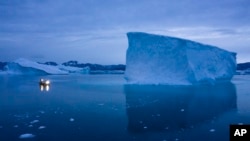Using 50 different satellite estimates, researchers found that Greenland's melt has gone into hyperdrive in the last few years.
Greenland’s average annual melt from 2017 to 2020 was 20% more a year than at the beginning of the decade and more than seven times higher than its annual shrinkage in the early 1990s.
The new figures “are pretty disastrous really,” said study co-author Ruth Mottram, a climate scientist at the Danish Meteorological Institute. “We’re losing more and more ice from Greenland.”
Study lead author Ines Otosaka, a glaciologist at the University of Leeds in the United Kingdom, said speeded-up ice sheet loss is clearly caused by human-linked climate change.
From 1992 to 1996, the two ice sheets – which hold 99% of the world’s freshwater ice – were shrinking by 116 billion tons (105 billion metric tons) a year, two-thirds of it from Antarctica.
The latest figures also showed what looks like a slowing of melting in parts of Antarctica, which has much more ice than Greenland. That’s mostly due to smaller and fleeting weather changes and the overall longer-term trend still shows an acceleration of melting in Antarctica, Mottram said.
Antarctica from 2017 to 2020 is still losing about 127 billion tons (115 billion metric tons) of ice a year, down 23% from earlier in the decade, but overall up 64% from the early 1990s.
But from 2017 to 2020, the newest data available, the combined melt soared to 410 billion tons (372 billion metric tons) a year, more than two-thirds of it from Greenland, said the study in Thursday’s journal Earth System Science Data.
"This is a devastating trajectory,” said U.S. National Snow and Ice Center Deputy Lead Scientist Twila Moon, who wasn’t part of the study. “These rates of ice loss are unprecedented during modern civilization.”
University of Colorado ice researcher and former NASA chief scientist Waleed Abdalati, who also wasn’t a study participant, said “This matters because rising sea levels will displace and/or financially impact hundreds of millions of people, if not billions, and will likely cost trillions of dollars.”




